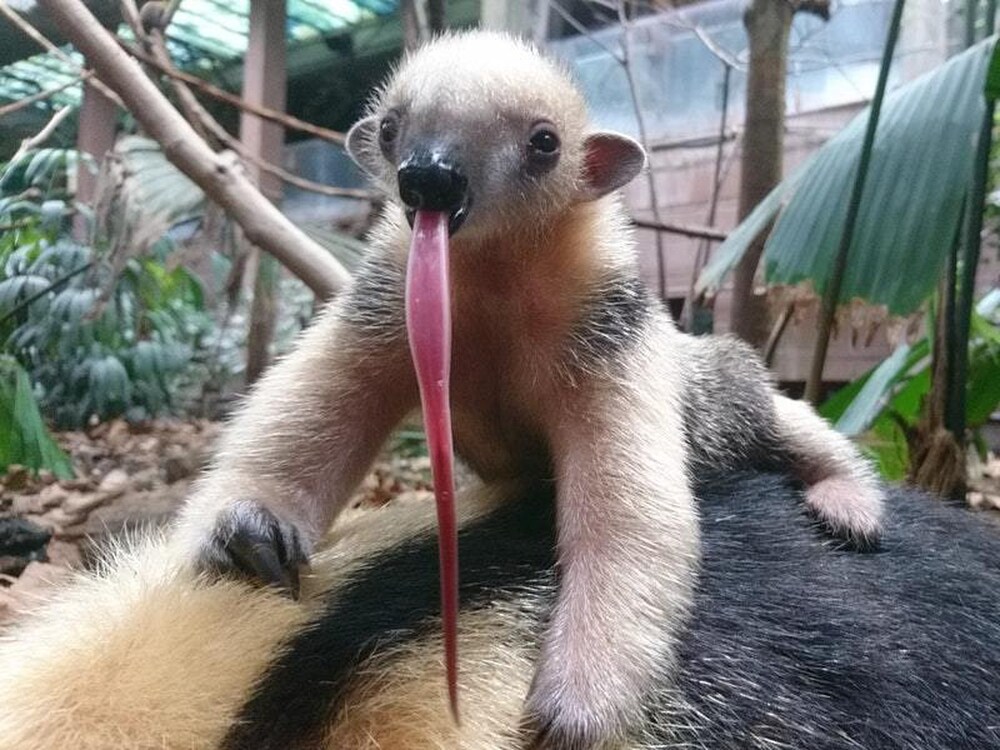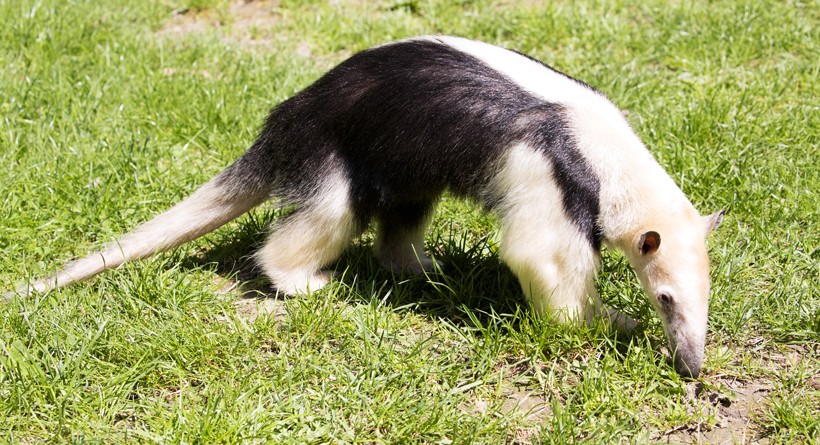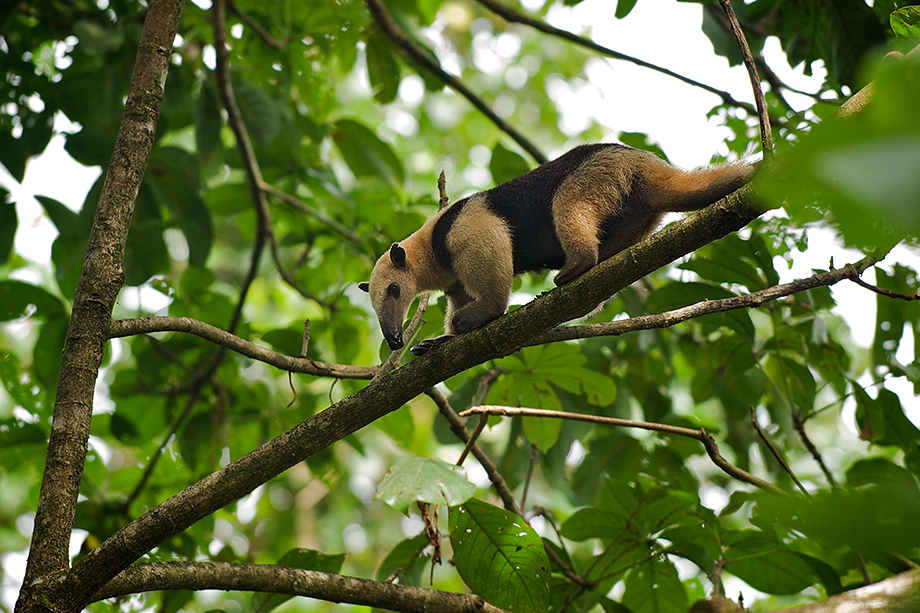Tamandua (pronounced tuh MAN doo wah) is often called a lesser anteater because it is much smaller than its relative, the giant anteater.
Tamandua is a genus of anteaters with two species: the southern tamandua (T. tetradactyla) and the northern tamandua (T. mexicana). They all belonged to the family Myrmecophagidae.
They live in forests and grasslands, they are semi arboreal and possess partially prehensile tails.The anteaters are more closely related to the sloths than they are to any other group of mammals. Their next closest relations are armadillos.
A baby anteater is called a Poco.

Baby Tamandua | Image: https://www.shropshirestar.com
They are frequently kept as an exotic pet and are also used occasionally by Amazonian Indians as a form of biological pest control, utilizing them to rid their dwellings of termites and ants.
The Two Species Of Tamanduas
1. Southern Tamandua

The Southern Tamandua has a 40 cm long tongue but doesn’t possess any teeth. Image: https://www.aboutanimals.com
The southern tamandua (Tamandua tetradactyla), also called the collared anteater or lesser anteater, is a species of anteater from South America. It is a solitary animal, found in many habitats from mature to highly disturbed secondary forests and arid savannas. It feeds on ants, termites, and bees. It’s very strong fore claws can be used to break insect nests or to defend itself.
2. Northern Tamandua

Northern Tamandua | Image: seancrane.com
The northern tamandua (Tamandua mexicana) is a species of tamandua, an anteater in the family Myrmecophagidae. They live in tropical and subtropical forests from southern Mexico, through Central America, and to the edge of the northern Andes.
Description Of Tamanduas
They have tapered heads with a long, tubular snout, small eyes, and protruding ears. Their tapered mouths house a tongue reaching upwards of 40 cm (16 in) in length. The tail is hairless and pink in color, marked with an irregular pattern of black blotches. The forefeet possess four clawed digits, the third digit bearing the largest claw, while the hind feet have five digits.
Their fur is thick, bristly, yellowish-white to fawn in color, often with a broad black lateral band, covering nearly the whole of the side of their bodies.
Northern tamanduas are marked with a black V on their backs and a “vest” over their torso, while southern tamanduas in the lowest part of their range are considerably lighter in color and may have only the V.
Behavior Of Tamanduas
The tamanduas are nocturnal, active at night and secreting away in hollow tree trunks and burrows abandoned by other animals during daylight hours. They can spend more than half of their time in the treetops, as much as 64%, where they forage for arboreal ants and termites.
They are rather clumsy on the ground and are incapable of galloping like their relative, the giant anteater. Tamanduas walk on the sides on their clenched forefeet to avoid injuring their palms with their sharp claws.
They manufacture a potent musk in their anal glands which they use for marking territory. They smear the strong smelling secretions on rocks, trees, fallen logs, and other prominent landmarks to announce their presence to other tamanduas.
When threatened while in the trees, they will firmly grasp the branch with its hind limbs and tail and rear up to confront its attacker with slashing motions of its large, curved claws. When on the ground, it will protect its vulnerable hindquarters by backing against a tree or a rock and lashing out with its forearms.
The tamanduas small eyes afford limited vision. Instead of relying on their sense of sight, they primarily utilize their senses of smell and hearing to locate their insect prey. They use their sharp claws and powerful forearms to tear open the nest of a colony of termites and employ their elongated tongues, coated with sticky saliva, to extract the insects.
Habitat And Diet Of Tamanduas
The tamanduas are able to adapt to a variety of habitats as needed.
It’s strange looks work to its advantage in its Central and South American forest and scrub habitat. Its kinky hair keeps angry ants from reaching the animal’s skin when dining at an anthill.
A powerful sense of smell helps the animal find a food source, like a termite mound. The tamandua feeds only a short time at each ant nest or termite mound so it won’t get many bites. This also helps ensure there are plenty of snacks at the same location the next time.
They mainly eat ants and termites, but they occasionally eat bees, beetles, and insect larvae. In captivity, they will eat fruits and meat.
Family Life Of Tamanduas
Tamanduas typically mates in the fall, and female tamanduas are capable of having multiple estrus cycles throughout the breeding season. Pregnancy lasts between 130 and 150 days, after which a single offspring is born.
The new baby does not resemble the parents very much, as its coat is a solid color, but its eyes are open, and it has those giant claws. The youngster spends the first part of its life on the mother’s back; she places her baby on a safe branch for a short time while she looks for food.
Some Interesting Facts About Tamanduas
- At 91 degrees Fahrenheit (33 degrees Celsius), tamanduas have one of the lowest body temperatures of any active land mammal.
- One tamandua stomach was found to contain more than 1 pound (0.45 kilograms) of ants.
- A smelly scent gives tamanduas the nickname “stinkers of the forest.” The animal can spray a foul-smelling secretion said to be four times more powerful than a skunk’s!
About Tamanduas
Tamanduas are called the lesser anteater because it’s relatively smaller than the giant anteater. It’s called the stinker of the forest because it sprays a foul-smelling secretion said to be four times more powerful than a skunk’s.
Article References:
- https://animals.sandiegozoo.org/animals/tamandua-or-lesser-anteater
- https://en.m.wikipedia.org/wiki/Tamandua







1 Comment
Pingback: The Plight of the Bumblebee - Favorite World Press